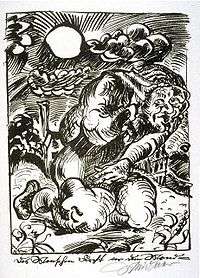Ludwig Meidner

Ludwig Meidner (18 April 1884 – 14 May 1966) was a German expressionist painter and printmaker born in Bernstadt, Silesia.[1] He was apprenticed to a stonemason, but the apprenticeship was not completed. He studied at the Royal School of Art in Breslau and, from 1906 to 1907 at the Académie Julian[2] and Cormon Academies in Paris where he met and became friends with Amedeo Modigliani. He returned to Berlin to work as a fashion illustrator and produced views of Berlin.
In 1912 he began a series of paintings that marked a radical departure in style and would make his reputation. The "Apocalyptic Landscapes"[3]are thought by some to anticipate the First World War. The series, produced rapidly in a hectic heatwave, are sometimes considered some of the purest "expressionist" works; in them, comets cross the sky like canon shells, fires rage, men scream and flee for their lives, buildings totter on the edge of collapse. Meidner would, however, never repeat the intensity and creativity of the apocalyptic landscapes.
After the First World War he turned to producing religious paintings including a long and repetitive series of portraits of "prophets". He was an habitual self portraitist producing a series of Rembrandt inspired self-portraits. His portraits from 1915 to the end of the 1920s are a gallery of the leading expressionist and Dada writers and poets.[4] Meidner himself increasingly turned to writing—he produced several books of dense expressionist prose and contributed to many newspaper articles.[5]
In order to escape antisemitic repressions he moved to Cologne where he became an art teacher at a Jewish School in 1935. In 1939 he fled with his family to England (his wife Else Meidner was also an artist) where he was interned as an enemy alien on the Isle of Man. He stayed in England,[6] unrecognised, hovering on the brink of poverty until 1953 when he returned to Germany. Although the years in exile were a period of hardship and disappointment, he created an extensive oeuvre of very original works during this time. Among those are drawings and watercolors on religious subjects, humoristic scenes and a cycle on the holocaust.[7]
In 1963 he had his first major exhibition since 1918 in Recklinghausen and Berlin. He died on 14 May 1966 in Darmstadt, aged 82.
Meidner's artistic bequest is now part of the collections of the Jewish Museum Frankfurt.
References
- ↑ global.britannica.com
- ↑ 2 paintings by or after Ludwig Meidner, Art UK
- ↑ Oxfordindex
- ↑ moma.org
- ↑ ushmm.org
- ↑ Benezit Dictionary Of Artists
- ↑ Eavesdropper on an age : Ludwig Meidner in exile. = Horcher in die Zeit. Ludwig Meidner im Exil. Munich: Hirmer. 1996. ISBN 9783777425863.
Bibliography
- Eliel, Carol S., "The Apocalyptic Landscapes of Ludwig Meidner", Los Angeles, California, Los Angeles County Museum of Art, 1989.
- Meidner, Ludwig, "Ludwig Meidner, An Expressionist Master", Ann Arbor, Michigan, The Museum, 1978.
- "Ludwig und Else Meidner" (exhibition catalogue in German and English) Frankfurt a. M. Jüdisches Museum Frankfurt, Ben Uri Gallery, 2002
- "Eavesdropper on an age : Ludwig Meidner in exile" (exhibition catalogue Museum Giersch der Goethe-Universität, Frankfurt am Main). Munich, Hirmer, 2016, ISBN 978-3-7774-2586-3 (Englisch); ISBN 978-3-7774-2554-2 (German)
External links
- Works by Ludwig Meidner at Project Gutenberg
- Works by or about Ludwig Meidner at Internet Archive
- Works by Ludwig Meidner at Jewish Museum Frankfurt
- online exhibition on Ludwig Meidner at Arts in Exile